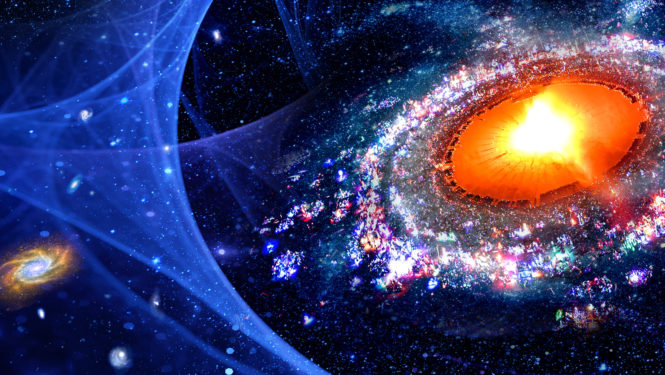“Do I contradict myself? Very well, then I contradict myself. I am large, I contain multitudes.” ―Walt Whitman

In the Wonderland of quantum mechanics, the tiny particles we are all made from exhibit strange and paradoxical behaviors. Quantum entanglement, first described in the 1930s, describes the ability of two entangled particles to behave identically even at great distances, and for one to react to a stimulus applied to the other, what Einstein called “spooky action at a distance.” The idea of quantum superposition is even spookier: the fact that something can exist in multiple potential states until it is observed, at which point it becomes either this or that, here or there, alive or not alive. As the joke goes, “Schrodinger’s cat walks into a bar. And it doesn’t.” The phenomenon has been well-documented, but how it actually works remains the subject of wild speculation. In one interpretation, the act of observation collapses the waves of possibility into one reality and the others instantly vanish. But there’s another explanation, called the Many Worlds theory, where all the possible choices continue to exist simultaneously as separate branches of reality, each one as real as the next.
“These parallel universes are not ghost worlds with an ephemeral existence; within each universe, we have the appearance of solid objects and concrete events as real and as objective as any.” ― Michio Kaku
“Why, sometimes I’ve believed as many as six impossible things before breakfast.” ― Alice in Wonderland
Physics throws up its hands and passes the buck to metaphysics to explain how and why these impossible things could possibly be. And metaphysics scratches its head at the answers that are suggested. Free will or predetermination? Yes! Real or unreal? Yes! How many angels can dance on the head of a pin? All of them, on an infinite or near-infinite number of pins! Dreamer or dreamt? Simulator or simulation? Wave or particle? Even time itself is suspect at the quantum level: just like its friend the Future, the Past may also be in a superposition of possibilities that crystallize only once they are observed. In the Many Worlds, everything that can happen does happen, possibly all at once.

When physics and metaphysics run out of answers, our best recourse may be to ignore them and ask better questions, using the tools of surrealism and pataphysics to break free from the tired bonds of logic. The surrealists famously drew on the power of dreams to do this, and developed tools like automatic drawing and Exquisite Corpse writing to access their dream-logic in waking life. A generation earlier, the French writer Alfred Jarry dreamed up pataphysics, the science of imaginary solutions, proposing that “the virtual or imaginary nature of things as glimpsed by the heightened vision of poetry or science or love can be seized and lived as real.” Viewed through the lens of quantum theory, both schools of thought seem to suggest the possibility of seeing – or perhaps even traveling – sideways across the branches of reality and experiencing other versions of one’s self and existence.
“When you come to a fork in the road, take it.” ― Yogi Berra
Artists and creative teams interested in exploring the Multiverse theme are encouraged to apply for honoraria grants. The application process begins here and will be open for submissions starting at Noon PST on October 15, 2019.
As always, any work of art by anyone, regardless of our theme, is welcome at the Black Rock City event. If you are planning to bring fire art or wish to install artwork on the open playa, please see our Playa Art Guidelines for more information.
Thanks to Tanner for the design and Jamen Percy for the multiversal Black Rock City photo.


